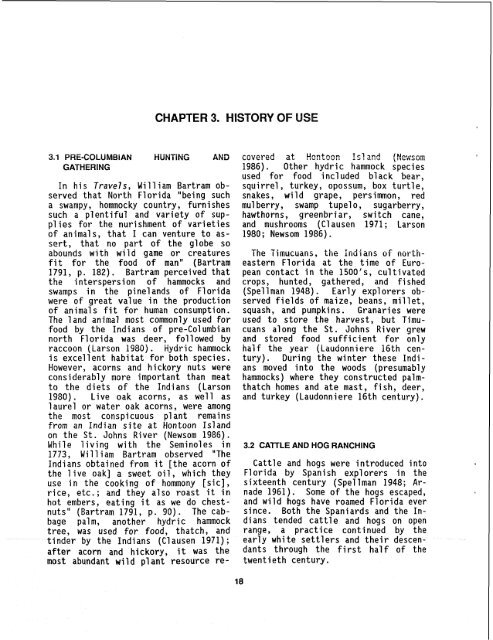a Guide to Management - USGS National Wetlands Research Center
a Guide to Management - USGS National Wetlands Research Center
a Guide to Management - USGS National Wetlands Research Center
Create successful ePaper yourself
Turn your PDF publications into a flip-book with our unique Google optimized e-Paper software.
3.4 PRE-COLUMBIAN HUNiiNG AND<br />
GATHERING<br />
In his Travels, William Bartram ob-<br />
served that North Florida "being such<br />
a swampy, hommocky country, furnishes<br />
such a plentiful and variety of sup-<br />
plies for the nurishment of varieties<br />
of animals, that I can venture <strong>to</strong> as-<br />
sert, that no part of the globe so<br />
abounds with wild game or creatures<br />
fit for the food of man" (Bartram<br />
1791, p. 182). Bartram perceived that<br />
the interspersion of hammocks and<br />
swamps in the pinelands of Florida<br />
were of great value in the production<br />
of animals fit for human consumption.<br />
The 1 and animal most commonly used for<br />
food by the Indians of pre-Columbian<br />
north Florida was deer, followed by<br />
raccoon (Larson 1980). Hydric hammock<br />
is excellent habitat for both species.<br />
However, acorns and hickory nuts were<br />
considerably more important than meat<br />
<strong>to</strong> the diets of the Indians (Larson<br />
1980). Live oak acorns, as well as<br />
laurel or water oak acorns, were among<br />
the most conspicuous plant remains<br />
from an Indian site at Hon<strong>to</strong>on Island<br />
on the St. Johns River (Newsom 1986).<br />
While living with the Seminoles in<br />
1773, Wi 1 1 i am Bartram observed "The<br />
Indians obtained from it [the acorn of<br />
the live oak] a sweet oil, which they<br />
use in the cooking of hommony [sic],<br />
rice, etc.; and they also roast it in<br />
hot embers, eating it as we do chest-<br />
nuts" (Bartram 1791, p. 90). The cab-<br />
bage palm, another hydric hammock<br />
tree, was used for food, thatch, and<br />
tinder by the Indians (Cl ausen 1971) ;<br />
after acorn and hickory, it was the<br />
most abundant wild plant resource re-<br />
CHAPTER 3. HISTORY OF USE<br />
covered at Hon<strong>to</strong>on f s! and (Newsom<br />
1986). Other hydric hammock species<br />
used for food included black bear,<br />
squirrel, turkey, opossum, box turtle,<br />
snakes, wild grape, persimmon, red<br />
mu1 berry, swamp tupelo, sugarberry,<br />
hawthorns, greenbri ar, switch cane,<br />
and mushrooms (Cl ausen 1971 ; Larson<br />
1980 ; Newsom 1986).<br />
The Timucuans, the Indians of nortk-<br />
eastern Florida at the time of Euro-<br />
pean contact in the 15001s, cultivated<br />
crops, hunted, gathered, and fished<br />
(Spell man 1948). Early expl orers ob-<br />
served fields of maize, beans, mi 11 et ,<br />
squash, and pumpkins. Granaries were<br />
used <strong>to</strong> s<strong>to</strong>re the harvest, but Timu-<br />
cuans along the St. Johns River grew<br />
and s<strong>to</strong>red food sufficient for only<br />
half the year (Laudonniere 16th cen-<br />
tury). During the winter these Indi-<br />
ans moved in<strong>to</strong> the woods (presumably<br />
hammocks) where they constructed palm-<br />
thatch homes and ate mast, fish, deer,<br />
and turkey (Laudonni ere 16th century).<br />
3.2 CAlTLE AND HOG RANCHING<br />
Cattle and hogs were introduced in<strong>to</strong><br />
Florida by Spanish explorers in the<br />
sixteenth century (Spel lman 1948; Ar-<br />
nade 1961). Some of the hogs escaped,<br />
and wild hogs have roamed Florida ever<br />
since. Both the Spaniards and the In-<br />
dians tended cattle and hogs on open<br />
range, a practice continued by the<br />
early white settlers and their descen-<br />
dants through the first half of the<br />
twentieth century.

















